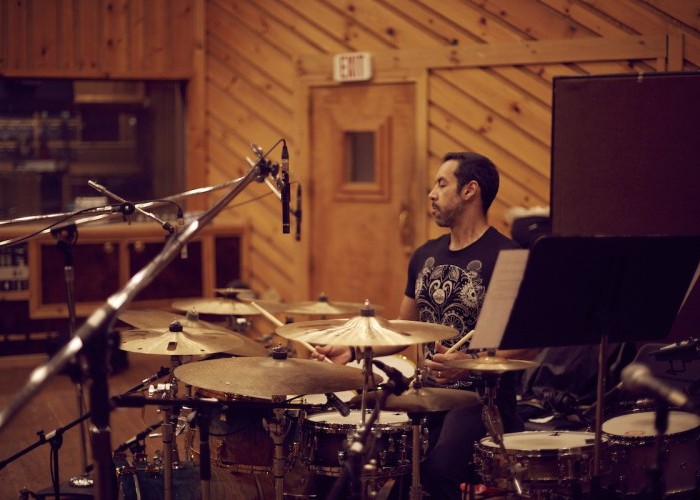Apr 2, 2024 12:59 PM
Saxophonist, Sonic Explorer Casey Benjamin Dies at 45
Casey Benjamin, the alto saxophonist, vocalist, keyboardist and producer who stamped his distinctive sounds on the…

Antonio Sánchez opens his latest album, Lines In The Sand, with a disturbing ontage of sirens and voices.
(Photo: Justin Bettman)In May 2018, drummer Antonio Sánchez was performing with pianist/composer Arturo O’Farrill at the Fandango Fronterizo, a trans-border festival at the 18-foot-high fence that separates San Diego, California, from Tijuana, Mexico. What impressed the him was how people on both sides of the divide were singing and dancing together to son jarocho.
For a moment, the fence disappeared.
Afterward, sifting through photos of the event, he came upon one of a girl in red playing on the beach, dwarfed by the towering black fence jutting into the ocean. This image became the cover of his latest album, Lines In The Sand (CAM), as well as the recording’s guiding metaphor. And it’s with this album that Sánchez captures the spirit of borderless music, making an unequivocal statement about humanitarianism.
Thematically, Lines In The Sand picks up where 2017’s Bad Hombre (CAM) left off. On the earlier release, Mexican-born Sánchez—a naturalized American citizen—challenged the disparagement of Mexicans then occurring in the American media. With the new album, he holds a magnifying glass up to immigration policies that he sees resulting from that denigration.
Lines opens with the violent sounds of families being separated, real-life audio clips of exchanges between United States Immigration and Customs Enforcement officials and unidentified men, women and children—some of whom are American citizens. This montage is the intro to “Travesía (Crossing),” an epic composition in three parts that matches Sánchez’s riveting grooves with oscillating electronics, dynamic strings and lyric wordless vocals. In a recent phone call, the bandleader explained his decision to lead with the most disturbing track on the record. “I wanted [sounds] on the album that were literal,” he explained. Not open for creative interpretation—and not so easily dismissed.”
Lines also recalls the 2017 album, compositionally. Sánchez extrapolated the melody for “Travesía” from an arpeggio that he liked on one of the earlier tunes. From the Bad Hombre title track, he borrowed a bass line to create the angular “Bad Hombres Y Mujeres.” And the current version of “Home” is almost identical to the previously recorded version, except that singer Thana Alexa, Sanchez’s wife and one-fourth of his group Migration, provided lyrics. (“Where is home on this road?” she sings, affectingly.) Bassist Matt Brewer, keyboardist John Escreet and saxophonist Chase Baird round out the ensemble.
For those looking for a Birdman redux, Sánchez’s compositions for Lines In The Sand, as always, contain plenty of filmic moments, though none of the extended solo drumming. “To me, one of the most fascinating things about composing or improvising is the development—it’s like storytelling,” he said. “The characters in this instance would be the melodies, the harmonic structure, the rhythms. So, I think, how many ways can I turn this around so that you get reminded that you’re listening to the same thing but in a different way?”
Sánchez gave as much thought to the narrative arc of Lines as a whole as he did to that of each composition. The album closes with the title cut, a mostly through-composed piece that unleashes into three solos back-to-back, before reverting to the tune’s initial structure. Like “Travesía,” “Lines In The Sand” lasts more than 20 minutes and uses spoken word—to sucker-punch effect. At the end of this track, slam poet Jonathan Mendoza (son of Victor Mendoza, Sánchez’s former professor at Berklee College of Music) recites his poem “Blood Country,” a dramatic reworking of the Pledge of Allegiance that lays bare the hard-won triumphs of Latin American immigrants.
Sánchez said that he closed the album on the Mendoza poem to leave his listeners with some hope amid all of the tough listens on this album. He doesn’t want this hope to obscure an all-important question, however: “If we were running away from famine, hunger, war, violence, persecution—how would we want to be treated?”
—Suzanne Lorge

Benjamin possessed a fluid, round sound on the alto saxophone, and he was often most recognizable by the layers of electronic effects that he put onto the instrument.
Apr 2, 2024 12:59 PM
Casey Benjamin, the alto saxophonist, vocalist, keyboardist and producer who stamped his distinctive sounds on the…

“He’s constructing intelligent musical sentences that connect seamlessly, which is the most important part of linear playing,” Charles McPherson said of alto saxophonist Sonny Red.
Feb 27, 2024 1:40 PM
“I might not have felt this way 30 to 40 years ago, but I’ve reached a point where I can hear value in what people…

Albert “Tootie” Heath (1935–2024) followed in the tradition of drummer Kenny Clarke, his idol.
Apr 5, 2024 10:28 AM
Albert “Tootie” Heath, a drummer of impeccable taste and time who was the youngest of three jazz-legend brothers…

“Both of us are quite grounded in the craft, the tradition and the harmonic sense,” Rosenwinkel said of his experience playing with Allen. “Yet I felt we shared something mystical as well.”
Mar 12, 2024 11:42 AM
“There are a few musicians you hear where, as somebody once said, the molecules in the room change. Geri was one of…

Henry Threadgill performs with Zooid at Big Ears in Knoxville, Tennessee.
Apr 9, 2024 11:30 AM
Big Ears, the annual four-day music celebration that first took place in 2009 in Knoxville, Tennessee, could well be…